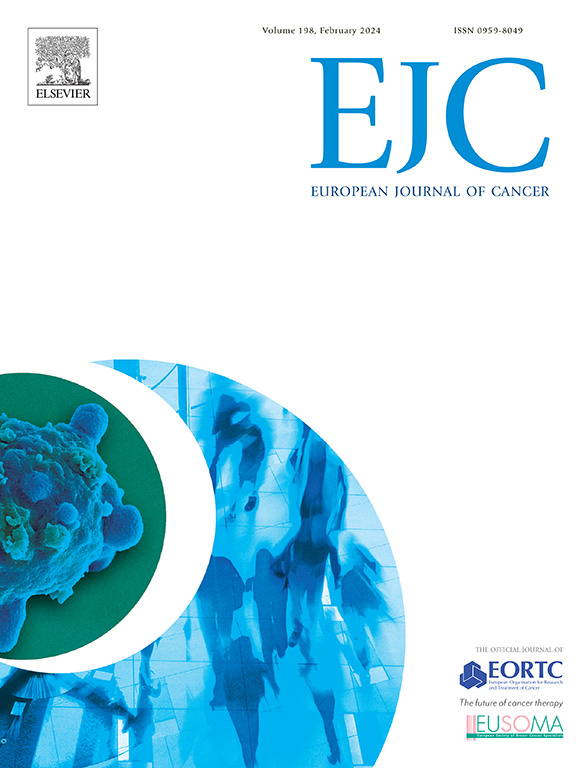Consolidation thoracic radiotherapy after chemoimmunotherapy in ES-SCLC: A multicentric retrospective analysis
IF 7.6
1区 医学
Q1 ONCOLOGY
引用次数: 0
Abstract
Background
The CREST trial established the benefit of consolidative thoracic radiotherapy (TRT) following first line (1L) chemotherapy in extensive-stage small cell lung cancer (ES-SCLC), demonstrating improved 2-year overall survival (OS). However, the role of TRT in the chemoimmunotherapy (CT-IO) era remains unclear, as TRT was excluded from registrational trials.
Methods
This retrospective study analysed consecutive patients (pts) with ES-SCLC treated with 1L CT-IO between January 2020 and January 2024 across 4 centres. Pts without radiological progression (PD) at their first post-treatment assessment were included. Intrathoracic recurrence rates, progression-free survival (PFS), and OS were compared between pts who received TRT and those who did not.
Results
336 pts were identified, with 111 (33.0 %) receiving TRT. Pts who received TRT had a lower rate of intrathoracic PD compared to those who did not (40.5 % vs 57.8 %, p = 0.003). Among those with intrathoracic PD despite TRT, only 21 (24.1 %) experienced PD within the radiation field. With a median follow-up of 31.3 months, pts who received TRT showed improved PFS (HR 0.89, p = 0.363) and OS (HR 0.82, p = 0.142), although not statistically significant. Multivariate analysis identified baseline liver metastases (LM) and stable disease after CT-IO as independent predictors of shorter PFS. Subgroup analysis revealed a longer PFS for pts receiving higher TRT doses (≥45 Gy vs <45 Gy) and those without LM.
Conclusions
In this series, TRT following 1 L CT-IO significantly improved intrathoracic control, although it did not translate into significantly better survival outcomes. Prospective trials are warranted to evaluate the impact of TRT on quality of life and survival.
ES-SCLC化疗免疫治疗后胸部巩固放疗:一项多中心回顾性分析
CREST试验证实了广泛期小细胞肺癌(ES-SCLC)在一线(1L)化疗后进行胸部巩固放疗(TRT)的益处,显示出2年总生存期(OS)的改善。然而,TRT在化学免疫治疗(CT-IO)时代的作用仍不清楚,因为TRT被排除在注册试验之外。方法本回顾性研究分析了2020年1月至2024年1月间4个中心连续接受1L CT-IO治疗的ES-SCLC患者。患者在第一次治疗后评估时没有放射学进展(PD)。比较接受TRT和未接受TRT的患者的胸内复发率、无进展生存期(PFS)和OS。结果336例患者接受TRT治疗,111例(33.0% %)。与未接受TRT的患者相比,接受TRT的患者胸内PD发生率较低(40.5 % vs 57.8 %,p = 0.003)。在接受TRT治疗的胸内PD患者中,只有21例(24.1% %)在放疗范围内发生了PD。中位随访31.3个月,接受TRT的患者PFS (HR 0.89, p = 0.363)和OS (HR 0.82, p = 0.142)均有改善,但无统计学意义。多变量分析确定基线肝转移(LM)和CT-IO后的稳定疾病是较短PFS的独立预测因素。亚组分析显示,接受较高TRT剂量(≥45 Gy vs <45 Gy)和没有LM的患者的PFS更长。结论在本研究中,1 L CT-IO后的TRT显著改善了胸内控制,尽管它并没有转化为显著改善的生存结果。有必要进行前瞻性试验来评估TRT对生活质量和生存的影响。
本文章由计算机程序翻译,如有差异,请以英文原文为准。
求助全文
约1分钟内获得全文
求助全文
来源期刊

European Journal of Cancer
医学-肿瘤学
CiteScore
11.50
自引率
4.80%
发文量
953
审稿时长
23 days
期刊介绍:
The European Journal of Cancer (EJC) serves as a comprehensive platform integrating preclinical, digital, translational, and clinical research across the spectrum of cancer. From epidemiology, carcinogenesis, and biology to groundbreaking innovations in cancer treatment and patient care, the journal covers a wide array of topics. We publish original research, reviews, previews, editorial comments, and correspondence, fostering dialogue and advancement in the fight against cancer. Join us in our mission to drive progress and improve outcomes in cancer research and patient care.
 求助内容:
求助内容: 应助结果提醒方式:
应助结果提醒方式:


